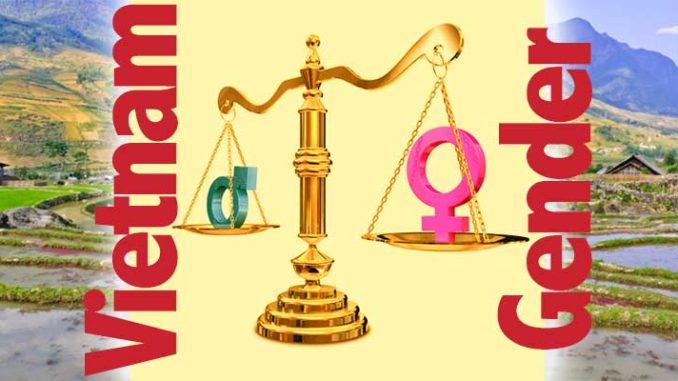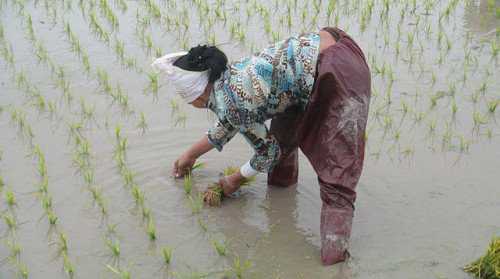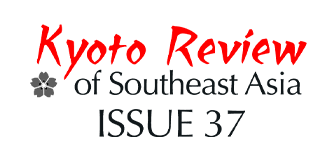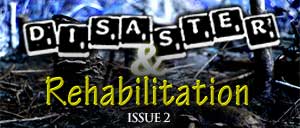
Vietnamese government efforts to protect forest biodiversity are centered on the creation of many new parks and protected areas. People living in these reserves are then resettled outside the boundaries of the parks, and those who have cultivation land inside the boundaries can no longer use it (Rambo et al. 1998:32). Neither are they allowed to collect natural resources inside the parks. Some local people have been offered contracts to protect the forest land or to replant forest in exchange for the right to collect firewood, but the benefits are quite small (about USD 3.00 per ha per year), unevenly spread, and unreliable. Moreover, problems of planning, overlapping land allocation mechanisms, lack of capital, and poor coordination between different levels of authority have led to encroaching cultivation in the reserves. As a result, poor locals—women in particular—lose the essential resources they count on to enrich their health and household income (Ireson 1996:2). As studies show that many of these people continue to depend on the forest for part of their livelihood, efforts to help them eliminate this dependence are crucial for them and for the better management of natural resources.
The Party and government of Vietnam have displayed great concern about eradicating hunger and reducing poverty among the rural population, especially communities living in remote mountain areas in and around the parks. Many innovative policies to promote rural development for the poor have been announced. Often these policies and programs are designed and implemented to benefit all people, both men and women. However, there is mounting evidence of gender inequalities in access to these benefits (Que et al. 1999:114). In addition, there is sometimes an apparent contradiction between policies designed to protect the environment and those intended to improve local living conditions, and these contradictions also affect men and women differently due to their different roles in the collection and use of natural resources.
This paper draws from case studies of communes located in two nature reserves representing two different ecological zones in Vietnam—Binh Chau-Phuoc Buu Nature Reserve in Ba Ria-Vung Tau province (in the Coastal Region of the South East), established in April 1993, and Kon Ka Kinh Nature Reserve in Gia Lai province (in the Central Highland Region), established in March 1999. While institutional changes in managing natural resources have had many effects on traditional resource use, I will focus on differences in women’s and men’s access to resources and technical training, gender differences in the collection and use of natural resources, the division of labor, and other factors affecting women’s participation in the development process.
The hamlets and their people
De Ktuc hamlet of Ayun commune (Mang Yang district, Gia Lai province) and Trang Tri hamlet of Bong Trang commune (Xuyen Moc district, Ba Ria-Vung Tau province) are located next to the official borders of Kon Ka Kinh reserve and Binh Chau-Phuoc Buu reserve, respectively. Approximately 30 percent of the total natural land of both communes is now managed by the reserves and is mostly classified as forest land, although only some of it is actually forested.
The sites were chosen to compare different ethnic groups whose daily activities are similarly connected to the nature reserves. All of the villagers in De Ktuc hamlet are of the ethnic minority Bana, while 94 percent of villagers in Trang Tri hamlet are Kinh, the majority ethnicity of Vietnam. The Bana are indigenous to the study hamlet, having lived there for generations, while the Kinh have migrated to Trang Tri hamlet since 1977, either as part of the new economic zone program or as spontaneous migrants. The Bana are historically matri-focused and matrilineal, in contrast to the majority Kinh’s patriarchal tradition. Bana women have traditionally been heads of families and decided issues related to the household economy. However, a comprehensive transition to a male-dominated patriarchal society is taking place, narrowing women’s sphere to domestic life while broadening men’s role in household economic management.
The Bana hamlet is very isolated, though it lies only 7 km from the commune center. On one side of the hamlet is forest that has recently become part of the Kon Ka Kinh reserve and on the other side is Ayun River. In the dry season, the riverbed is often dry and can be easily crossed for access to other hamlets and the commune center. But in the rainy season, from roughly April to November, the river floods and isolates the hamlet. In contrast, the Kinh hamlet is located less than 1 km from its commune center and a sealed road crosses the hamlet. This makes travel to other communities very convenient.
Rice cultivated in paddy and swidden fields is the basic food supply of both hamlets. Like most upland ethnic minority groups in Vietnam, the Bana have long practiced shifting cultivation (swidden farming), which has been identified by the government as a serious threat to the natural environment, though this system was relatively sustainable under conditions of low population density. It is no longer sustainable in light of intensive commercial exploitation of forest products, rapid natural population growth, and substantial Kinh in-migration from the lowlands (e.g., 39 percent of the total population of the Bana’s Ayun commune are Kinh immigrants). An irrigation system has recently been established in De Ktuc hamlet to introduce wet rice cultivation to the Bana, who continue to supplement their rice supply through swidden agriculture. The Kinh cultivate wet rice in the lower parts of their adopted hamlet with no irrigation system and grow industrial cash crops on other land. As paddy land in both hamlets is of very poor quality and quite limited, the poorer villagers in particular rely on natural resources collected from the nature reserves and small plots of subsidiary crops cultivated within the reserves.
Under the management of the Nature Reserve Management Board, villagers are officially not allowed to freely collect any wild forest products or to cultivate upland fields, though enforcement of the rules differs between the two nature reserves. In the Central Highland Kon Ka Kinh reserve, the Bana can still go to the forest to collect bamboo shoots, dot, honeycombs, and firewood. In the Coastal Region Binh Chau-Phuoc Buu reserve, villagers are hindered from doing so by a newly completed metal fence. Although in practice villagers still work their former cultivation sites in upland areas inside the reserves, this land tenure is not recognised by law and depends entirely on the flexibility of the nature reserve management boards.
The agroecosystems of the Bana of De Ktuc and the Kinh of Trang Tri consist of paddy cultivation in small flat areas; highland cultivation, either on their own land or land recently allocated to the nature reserves; home garden cultivation; animal husbandry; and collection of natural resources from the forest. Changes in local environment and land management practices have certainly affected the collection, use, and sale of natural products, but they remain an integral part of the land-based subsistence and income-generating activities of the study hamlets. Collecting non-timber forest products (NTFPs) and hunting small animals inside the nature reserves are economically important to both ethnic groups and culturally important to the Bana. The cultural differences between the Bana and the Kinh have stimulated somewhat different adaptations in their agroecosystems, which are reviewed below.

The agrosystems of De Ktuc and Trang Tri hamlets
Paddy fields: The paddy areas of both hamlets are very small, averaging 180 m2 per person. Not a traditional element of Bana culture, wet rice cultivation was recently introduced by a government rural development program; therefore the adaptation process is still under way. All their paddy fields are capable of producing two crops because the new irrigation system controls water for both dry and rainy seasons. However, only one third of the total paddy area has been growing two rice crops with new non-local varieties. The remaining paddies are cultivated with the familiar local variety, which only produces one summer crop. In the Kinh hamlet, where there is no irrigation system, villagers can cultivate only one rice crop in the rainy season. They wish to have an irrigation system in order to be able to grow two rice crops.
In both ethnic groups, men commonly are responsible for preparing the soil, women for transplanting and weeding. Due to infertile soil and lack of fertilizers, rice yields in both hamlets are very low, reaching only 2.0-2.5 tons/ha in De Ktuc and 3.0-3.5 tons/ha in Trang Tri. Paddy allocations do not supply adequate rice for household needs in either hamlet, providing them with only enough rice for two to four months of the year.
Upland fields: Upland farming is therefore an important supplement to paddy cultivation, but the crops grown and their management differ between the two hamlets. Most households farm cassava, maize, and beans, but the Bana still practice swidden rice cultivation as the main crop in their upland fields. In contrast, the lowland Kinh immigrants have cultivated industrial crops in the uplands since they moved to the study village—cashew nuts, pepper, and recently fruit trees. In the last decade, however, upland fields in both hamlets have decreased significantly due to restrictions on freely extending cultivation and the allocation of previously cultivated land to state forest enterprises and nature reserves.
Moreover, because of population growth and changes in forestland tenure, the fallow period has become very short or even nonexistent. The Bana now often plant rice or intercrop swidden rice with local varieties of cassava, then leave the fields fallow for only a couple of months, where they traditionally left fields fallow for fifteen to twenty years. Swidden-rice yield is now 0.8-1.0 ton/ha/year and cassava yield about 10 tons/ha/year. In De Ktuc hamlet, the swidden rice that used to be the main food of villagers now supplies enough for only two to three months per year. In sum, although the Bana have additional rice from swidden fields, this rice together with wet rice provides only enough grain food for four to seven months of the year.
The Kinh migrants have been cultivating cashew nuts and pepper for a couple of decades. Cassava and maize have been planted either under the young cashew nut trees when their canopy has not yet fully developed or in separate plots. But the Kinh have applied lowland cultivation techniques—using cattle to plough fields—that are not suitable for the sloped land. Consequently, the soil has become infertile. The yield of cassava was about 18 tons/ha last year; maize was 1-1.5 tons/ha; cashew nuts was 0.5 tons/ha; and pepper was about 2 tons/ha.
Both Kinh and Bana men and women clear and fence the cleared upland areas, plant swidden rice or other crops, and do swidden weeding. While the Bana men commonly select the land for swidden and do the initial clearing and burning, the Kinh men and women share this work, though Kinh men are more involved in land preparation than their female partners. Family members work together to harvest and carry upland farming products to the villages.
Home gardens: Most households have home gardens adjacent to their residential areas, which mostly provide vegetables for basic household consumption. Recently small numbers of fruit trees have been planted. But lack of water and poor soil quality, and in the Bana hamlet free-ranging domestic animals, have prevented the home gardens from contributing much to local livelihoods. Women in both groups are primarily responsible for the home garden.
Animal husbandry: Cattle, water buffalo, pigs, and chickens are raised in both hamlets. While all of these animals roam freely in the valleys and around the houses of the Bana hamlet, in the Kinh village cattle and buffalo are grazed under the control of villagers, pigs are kept in cages, and chickens are free ranged only during the day. Goats are also raised by the Bana and fishponds have been constructed in recent years by the Kinh. While the Bana use meat mainly in weddings, funerals, traditional holidays, and festivals, the Kinh also use it as a commodity. The raising of livestock has not yet developed intensively in either community, and is therefore not a great source of income for households. The establishment of the nature reserves has also narrowed the area available for animal grazing. Women and children do almost all of the work in raising these animals.
Forest products: During rice shortages—experienced by most farming households in both hamlets every year—food needs are met in the surrounding forest and uncultivated land. Small animals are hunted or trapped in both hamlets, although the Kinh are not good hunters and have largely given it up. However, the forest can immediately and frequently supply them with food, firewood, construction materials, and other materials that can be sold for income to purchase food and basic daily necessities.
Gender differences in access to resources
Productive, reproductive, and community work all require resources, the most important of which are land, capital, and technical training. Engaging in work and using resources generate benefits for both men and women, but access to these resources differs by gender and this differential in turn influences opportunities in the development process. As women get less opportunities, they depend more on natural resources, which are simultaneously becoming less available. Eventually their own livelihood and the living standard of their families decline.
Access to land: Almost everyone living in the two hamlets is a farmer, making land the most important asset for daily activities. The 1993 Land Law and all legal documents related to land issued since 1993 stipulate that all agricultural inhabitants registered in a locality are target groups for land allocation, without discrimination based on gender, ethnicity, or age (Van Anh, 1999: 102). Under the law, women farmers have the same access to land as do men.
In the Kinh village of Trang Tri, land has been allocated according to the law and “red books” (land use certificates) have been issued to individuals and households. The certificates are the sole document recognizing the right of farmers to use land and are issued under the name of the family head. As about 80 percent of the households are headed by men, they are also the holders of the land use certificates. The 20 percent of households headed by women include those whose husbands are absent, as well as unmarried and widowed women, and they receive land use certificates for their households. Trang Tri hamlet authorities say that the actual name on land use certificates is not important because if the husband wants to sell land, he needs the signature of his wife. However, in interviews, female villagers expressed fear that their land use rights may be trampled on because their names do not appear on the certificates.
In De Ktuc hamlet, land has not yet been allocated under the current law. In the absence of land use certificates and with an increase in spontaneous immigration to the region, an unofficial land market has sprung up. The rising price of land pressures villagers to sell out, even their swidden land inside the nature reserves. As the extension of swidden land is prohibited by recent regulations, this is increasing the number of villagers becoming totally or partially landless. In sum, unofficial land purchases lead to deception, illegal occupation, and forcible sales in which local farmers, especially women, are often the victims. We found that Bana husbands are able to sell family land without the permission of their wives because the men, unlike most women, can speak the Kinh language to communicate with outsiders.
Gender differences also influence access to sub-contracts for tree replanting in barren land or protection of regeneration forest. These contracts are often gained by male-headed households which command more resources and access to social networks than than those headed by poor or ethnic minority women. Forest protection contracts in Kon Ka Kinh are undertaken by Bana husbands whose wives neither participate in nor understand complex contract procedures, market prices, and land valuation.
Access to agricultural and forestry extension: Approximately 60 percent of farmers in the two hamlets are women. However, intensive modern farming techniques are more accessible to men in the study areas. In Trang Tri hamlet, technical training is undertaken in association with the local Farmers’ Association and the Agricultural and Forestry Extension Club. Women make up only 2 percent of the membership of the farmers’ association and 35 percent of the extension club. In 2000, 35 percent of extension program trainees in Trang Tri and 9 percent in De Ktuc were women. (The lower participation of Bana women is probably due to language barriers.) Women interviewed said that they would receive no information about the extension training if they did not participate in these mass organisations. Their own organization, the Women’s Union, is not a “partner” of the training programs.
Women’s heavy workload has also hindered them from gaining technical training. The division of labor in local families sees women devoting much more time and work to both production and reproduction. Women interviewed in Trang Tri are involved in more than twice as many work tasks as their partners, while in De Ktuc the figure is a little under 1.5 times. Traditional perceptions of the role of women in agriculture also plays a role. In De Ktuc hamlet, male authorities say that Bana women lack sufficient literacy, have no time, and have too many obligations at home to attend technical training.
Access to credit: In the transition period to a market economy in Vietnam, the need for capital has been increasing for both men and women. Access to credit helps farmers improve their livelihoods through investment in production. In recent years, the government has been concerned about developing the rural economy, especially in remote areas, and many other capital sources have expanded in the study areas, making money available for productive investment. There are two types of credit programs—bank micro-credit programs and women’s micro-credit programs managed by the local women’s union. Access to both of these types of credit by women in the study hamlets is very low.
The bank credit program includes loans from the Agricultural Development Bank and the Bank for the Poor. The loan procedure is complicated and accompanied by much paper work. This process constrains rural women, especially those who are limited by educational level and access to information. Women also lack the required collateral because land use certificates are in their husband’s or father’s names. Only 32 percent of women in Trang Tri and 20 percent of women in De Ktuc have accessed bank credit programs.
The Vietnam Women’s Union has credit programs in both study hamlets. Although its procedure is simple and does not require collateral, the conditions for receiving loans are very strict. Only active women’s union members with good production proposals believed to have the potential to pay back the money can get loans, which are very small and managed at the local level. Only 21 percent of women’s union members in Trang Tri (where 55 percent of women are members) qualified for these loans; 33 percent of De Ktuc members (where 39 percent are members) were able to access this source of credit.
Access to natural resources: Women collect a variety of natural products which they are likely to devote directly to family use, although they also sell products to meet basic household needs.
During the upland cultivation season, the energy of many women is devoted to swidden fields and the care of small children. Despite these constraints, firewood, bamboo shoots, medicinal plants, and vegetables for the daily consumption of humans and animals are all collected by women in the two study hamlets. Bamboo shoots appear to be regularly harvested as a supplement to the Bana’s basic staples of rice and cassava. During times of hunger and rice shortage, firewood and bamboo shoots can also be sold in the local market to buy rice. If a Bana woman spends the whole day collecting bamboo shoots, she can earn 10,000 VND (USD 0.70). In recent years, the collection of bamboo shoots has been decreasing because the forest area has become smaller and the shoots have become less available in the forest. In Trang Tri hamlet, bamboo shoots are now rarely found in the nearby forest.
Collecting “broom grass” (Thysanolaena maxima) in the forest in De Ktuc and making charcoal in Trang Tri have brought regular cash income for women. Broom grass is collected in fallow and bare fields by the Bana in Kon Ka Kinh nature reserve. The average amount of grass collected in a year earns 100,000 VND (less than USD 7.00). Charcoal is made by burning small dried timber branches, then watering and collecting them the same day. Two bags can be produced in a day and sold for 20,000 VND (less than USD 1.50) in the local market. This amount of cash helps poor women meet their daily rice consumption and other basic family needs. In Trang Tri, the recent stricter enforcement of nature reserve rules has seen more villagers getting caught and fined for making charcoal and cutting down trees in the nature reserve. According to forest protection officers, no exceptions are made for male villagers when they break rules, but they are often made for arrested female villagers. This is because poor women are less likely to have money to pay fines, and when arrested, their small children often come and cry heart-rendingly. Forest rangers feel sorry for the women and are more likely to release them than the men. Consequently, more poor women now make charcoal, a job that used to be shared with men, and more women are carrying pieces of timber from the forest, traditionally a male job.
Men, in contrast, seem to collect natural products less regularly and for specific needs, such as income, meat, or house repair. They are more likely to sell their collected natural products, although some are for household use, and their activities typically require greater physical strength, such as carrying large pieces of timber and climbing tall trees to collect honey. The timber is logged for house building and repair and to make family furniture. Villagers in De Ktuc are presently allowed to cut timber to build a new house or repair an old house only with the approval of local authorities; this activity is totally banned in Trang Tri hamlet. Illegal logging has been occurring in both hamlets. The locals are actively engaged as guides and workers hired by outsiders who manage the timber trade and receive most of its profits. Some illegal loggers in both hamlets are poor young men forced to cut trees in order to pay back debts owed to the organizers of illegal logging.
Hunting is a traditional activity of the Bana locals while it is an adopted activity of Kinh immigrants in Trang Tri. In recent years, hunting has declined in both hamlets. Firearms are banned and their use strictly punished. Trapping is the main method of catching animals, used for squirrels, wild pigs, rats, muntjac, and other small animals. The De Ktuc authorities comment that hunting in the Bana community is unlikely to exert significant pressure on wild animal populations.
Both men and women in De Ktuc collect honey from the hives of wild bees. Honey can be sold for 25,000-30,000 VND (about USD $2.00) per litre in the local market. However, in recent years honey has become scarcer, suggesting that this resource has been overexploited.
Women’s participation in decision making
The case study suggests that significant gender inequality exists on the community level and within families in decision-making relating to resource control and rural development. The number of women involved at the local leadership level in the study communities is very low: only 16 percent of peoples’ committee members in Ayun commune and 15 percent in Bong Trang commune. Female leaders at the hamlet level are also very few. Aside from the chairpersons of Women’s Unions, only one of thirteen hamlet leaders (5%) in Bong Trang commune is a woman, while there are no female hamlet leaders in Ayun commune (Table 1).
Table 1: Women in local leadership in two study communes in 2001-2004
|
Position |
Ayun Commune |
Bong Trang Commune |
||
|
|
Men |
Women |
Men |
Women |
|
Member of Commune People’s Committee |
84% |
16% |
87% |
13% |
|
Member of commune assembly |
84% |
16% |
85% |
15% |
|
Hamlet head |
100% |
0% |
95% |
5% |
Source: Women’s Unions and People’s Committees of two study communes
In most interviewed families, men have the last word in making decisions about production, allocation of family resources, the development direction of the family, and the future of children. In our survey, male and female respondents were asked to indicate gender differences in family decision making. The results are presented in Table 2.
Table 2. Decision making in families by sex (%)
|
Decision makers |
De Ktuk (n= 37) |
Trang Tri (n=29) |
|
Cultivation
|
65% 16% 19% |
57% 26% 17% |
|
Animal husbandry
|
34% 50% 16% |
40% 50% 10% |
|
Exploitation of forest products
|
38% 51% 11% |
31% 48% 21% |
|
Financial management
|
52% 32% 16% |
55% 35% 10% |
|
Education of children
|
76% 8% 16% |
50% 41% 9% |
Source: field research data
The traditional land use and crop control system practised by women is being replaced by expensive and externally designed methods brought in by men. The transition from traditional food crops to commercial crops (in Trang Tri) or wet rice cultivation (in De Ktuc) involves the introduction of new techniques. Decision-making power over seed selection and crops no longer belongs to women. Men are making this transition more successfully because of favorable access to technical training and their capacity to travel and engage in barter with outsiders.
Decisions regarding the use and collection of natural resources as well as animal husbandry (cattle, pigs, and chickens) are often made by women rather than men in both study villages (Table 3). These are important sources of income, especially forest collection for poor families. In general, women keep track of household expenditure.
Livestock purchases and sales are often made by men. This disproportionately male-dominated decision making poses a threat to household well-being, which is maintained by women. This has a significant impact on management and resource use patterns.
Gender and institutional changes in managing natural resources
Changes in the agroecosystem in the hamlets of De Ktuc and Trang Tri affect men and women differently. Declining swidden cultivation land due to land tenure change meant to conserve biodiversity has essentially created barriers to the well-being of the rural poor, shifting the burden especially to poor women. Shortening swidden fallow time and lower yields mean more work for women—more intensive cultivation in order to produce the same amount of food and more intensive weeding because shorter fallow periods allow weeds to grow faster. Moreover, the development of home gardens, the responsibility of women and children, has begun to be an important source of supplementary food.
Nature reserves, which seem to conserve natural resources ultimately in the interest of the state, have created boundaries between people and the resources that have traditionally played an important role in community well-being. Insufficiency of land to meet food needs results in intensified collection and sale of natural products. A greater number of women collect firewood and charcoal from the two nature reserves to generate cash for food. These activities have been totally banned in Binh Chau-Phuoc Buu reserve and fines have been imposed when collectors are caught gathering in the reserve, yet gathering continues. Strict rules have also required women to spend more time foraging at greater distances in order to avoid being caught and to produce substitutes for forest products.
As agricultural growth declines, forest resources become increasingly limited, and population growth continues, more families are forced to turn to wage labor in order to purchase food. In Trang Tri, for example, more men than women have been involved in this activity, which usually entails heavy physical labor for low pay. With the absence of their husbands, poor womens’ labor becomes the mainstay of the household economy, which causes greater suffering. This trend has been underway in Trang Tri but not yet in De Ktuc.
Less access to land, capital, education, and agricultural technical training affects women’s efforts to find other opportunities of employment and income, which would help reduce pressure on the forest. Thus, poor women in particular, marginalized to the sphere of family survival, have less choices available to respond to the declining access to natural resources. As one Kinh woman in Trang Tri said of illegal charcoal-making, “We have been caught many times but we continue to go to make it. What can you do when your house has no food or your children are sick? We need to survive at any cost.”
Changes in the natural environment and natural resource management practices may be more harmful to women because so few of them participate in decision making. Local male decision makers view the world through the lenses of their own experiences and interests. Survey results suggest that in projects to improve local livelihoods, up to now men have benefited more than women.
Policy considerations
The findings of our study, though still preliminary, raise points that merit urgent consideration. Men and women experience their local world differently and have different knowledge about and interests in that world. Knowledge of these gender differences should enable policymakers to design better policies to protect nature reserves, the main tool for biodiversity protection, while solving problems of unequal access to land and resources. It is suggested that in planning for the establishment of nature reserves, equitable solutions for the loss of cultivation land classified inside nature reserves should be clearly addressed. For example, men and women should be equally considered for sub-contracts to plant and protect forests.
Moreover, existing land regulations and laws should be revised so that women are listed on land certificates as co-owners of plots allocated to male-headed households; otherwise women will continue to be disadvantaged in access to land. This case study indicates that another fundamental problem is women’s exclusion from positions of power in local government. In order to empower local women, the structure of local government should be designed so that female villagers who have knowledge and capabilities are given leading positions. At the same time, Women’s Unions should encourage and train capable members to participate in local government.
In development projects, a quota system should ensure equal numbers of male and female participants in all stages; specific credit programs for women should provide them with favorable access and training in how to use loans; women should be provided prior technical training; and the executive board of nature reserves should include women in conservation dissemination and educational activities. Priority should be given to local women who are trained and have a good knowledge of conservation.
Tuong Vi Pham
Tuong Vi Pham, M.A., works at the Center for Natural Resources and Environmental Studies Vietnam National University, Hanoi. She conducted the field research for this paper between September 19 and 26, 2001, in Binh Chau Phuoc Buu Nature Reserve, as a part of a research team that included Dao Trong Hung and Nguyen Manh Ha from the Center for Natural Resources and Environmental Studies (CRES). Members of this team, Ma Thi Bac, from Tay Nguyen Forestry College, and Nguyen Thi Minh Hoa, from Gia Lai Provincial Women’s Union, also undertook field research for one week in June 2001 in Kon Ka Kinh Nature Reserve. Funding support was provided by the Project of Strengthening Protected Area Management (SPAM) and the Central Department of Forest Protection of the Ministry of Agricultural and Rural Development (MARD) of Vietnam. Each team member has written individual notes, and this paper has used some information from those notes. The author acknowledges these contributions. Given the limitations on time and the amount of data collected, the conclusions must necessarily be tentative and subject to change as more and better information becomes available.
Kyoto Review of Southeast Asia. Issue 2 (October 2002). Disaster and Rehabilitation
References
Bo Lao Dong-Thuong Binh va Xa Hoi. 2000. Van De Gioi trong Chuong Trinh Muc Tieu Quoc Gia Xoa Doi Giam Ngheo Giai Doan 2001-2010. (Gender issues in the national program for hunger eradication and poverty reduction in the period 2001-2010). Hanoi.
Ireson, Carol and W. Randall Ireson. 1996. Cultivating the Forest: Gender and the Decline of Wild Resources among the Tay of Northern Vietnam. Working Paper No. 6. Honololu: East-West Center.
Que, Tran Thi, Vu Ngoc Uyen, and Nguyen Thi Bang. 1999. Nhung Khai Niem Co Ban Ve Gioi va Van De Gioi o Viet Nam (Basic gender concepts and gender issues in Vietnam). Hanoi: Nha Xuat Ban Thong Ke.
Rambo, Terry, Le Trong Cuc, Dao Trong Hung, and Tran Duc Vien. 1998. People in a park: The human ecology of the Dan Lai ethnic minority in Pu Mat Nature Reserve, Nghe An Province, Vietnam. Unpublished paper for the East-West Center and the Center for Natural Resources and Environmental Studies.
Van Anh, Tran Thi. 1999. Women in rural land in Vietnam. In Women’s Rights to House and Land: China, Laos, and Vietnam, ed. Irene Tinker and Gale Summerfield. Boulder, CO: Lynne Rienner.




